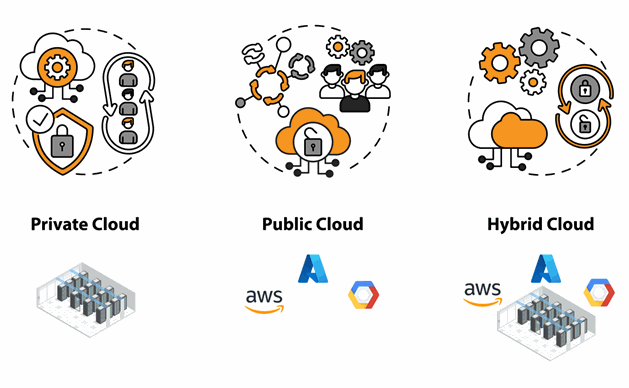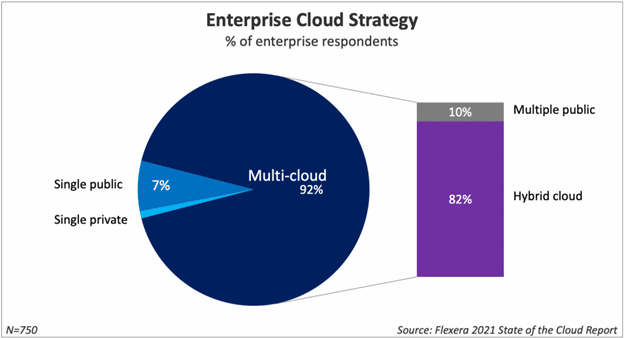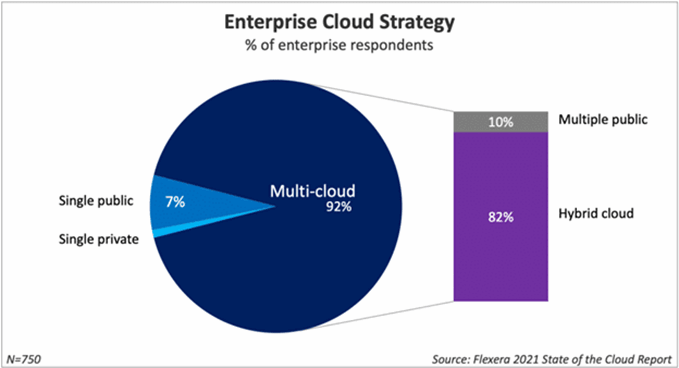For more information on your charming neighborhood CSW Solutions, visit us at our home or subscribe to our newsletter! We also do that social networking thing at: Twitter, Facebook, Linkedin, and Instagram! Check out our #funfactfridays
What is Hybrid Cloud?
The remote and hybrid work model isn't going anywhere, in fact, 90% of enterprises expect cloud usage to exceed prior plans this year due to Covid-19. Along with the remote workforce comes the increased demand for cloud resources to support the growth of remote access and data security.
Many companies already have their own on-premises datacenters that they maintain with their own servers, routers, and switches with their own methods of compliance and security protocols, that have likely been in place for years. But as every business has learned in the past few years, innovation has merit in periods of recovery from disruption and uncertainty. Cloud innovation is where it's at these days and it isn't slowing down any time soon.
In this post, we will focus on the hybrid cloud and multi-cloud solutions that not only maximize on-premises investments but vastly improve the agility of business infrastructure and growth possibilities while also advancing the breadth of data protection and security.
What is Hybrid Cloud?
Hybrid cloud is made up of two different cloud environments that you are already familiar with, a public cloud and a private cloud. So first, let's breakdown the two environments.
Public Cloud - A public cloud is a third-party vendor or cloud provider that sells their own datacenter resources to customers. It is basically the rental of someone else's infrastructure setup. The cloud provider manages all the upkeep and maintenance of their datacenters. Each customer's data is essentially layered in the cloud with their own system of governance and control. Companies like Amazon, Microsoft, and Google are considered public cloud providers and it is very likely you already use them for personal and/or private data storage and backup. We jut recently covered Amazon AWS and Microsoft Azure in a previous post. But not everything belongs or feels secure moving to a public cloud. Right?
Private Cloud - A private cloud is a more permanent environment that is dedicated solely to you and protected behind your company's firewall. It is the most common type of environment, where a business or organization owns and maintains all the infrastructure, hardware, and software to run a cloud on their own private network. It is more common because it has been the only way we've managed data and IT infrastructure for the last few decades. Usually, these environments are on-premises but off-site datacenters are also used to minimize costs or resources by sharing maintenance and space. But maintaining your entire underlying computing infrastructure can be unpredictable and stressful with environmental concerns, costly resources, and never-ending physical/virtual/psychological maintenance!

The hybrid cloud can benefit your business operations in a few ways. It can be part of a series of phases to build out your cloud migration as you train your team to adapt to cloud-based tools and services. It can also be a two-fold solution to utilize the public cloud as an added asset. In this case for example, you could keep your database running on-premises but then run your web application on the public cloud.
Hybrid cloud is also often used for cloud bursting. It begins with an existing on-premises infrastructure or private cloud but when demand exceeds capacity, you can burst to a public cloud so there is no interruption of services. This cloud bursting is just as cool as it sounds.
There are many other compelling reasons why the hybrid cloud is beneficial to business and growth strategy, it also expands your options and availability in resources to protect and retain the highest level of access to your assets while taking steps to achieve a cloud-native architecture. High availability is key to the protective measures that are necessary in data security and readiness. There is no better option to ensuring your critical applications are operational even through hardware failures, software issues, human errors, and site-wide disasters —more than any other solutions.
What About Multicloud?
That's easy. Multicloud is where there are two or more added public clouds for your workload. It's just like hybrid cloud but it provides even more benefits for a few reasons.
Reduce Latency - First, it allows you to replicate the same workload on multiple clouds. This allows a company to reduce latency by increasing distribution to service their team or users from the nearest physical datacenter to their location. It also means higher availability. If there is ever an outage or in a worst-case scenario, your cloud provider goes under, you'll have more available resources to draw from as back-up without compromising operations and services.
Split the Workload - Another reason is where a multicloud solution lets you split the workload. You can choose the best features of each cloud provider and use those to your benefit, based on what you need and when you need it. This ability to pick and choose is like picking the best stats from each hero in your lineup of characters you like and making a superhero out of them. So you can make your business a superhero. In your head, of course.
Mergers - Multicloud is also useful for when two companies with two different cloud providers merge. With the prevalence of mergers and acquisitions, the size and complexity of bringing multiple moving parts together have been a big aspect of multicloud solutions. Each company has the ability to maintain their own services while data and workload integration proceed. As is common with cloud solutions, scalability is key to the success of these mergers using multicloud. Enterprises have almost entirely embraced multicloud, according to an earlier report from Flexera this year.


Challenges of Hybrid Cloud and Multicloud
Whether you want to keep one foot on the ground or take the full leap into the cloud, the hybrid or multicloud strategy will work for you. Either way, the strategy for hybrid cloud deployment needs to be planned, managed, and implemented by trained and certified personnel. That leads us to our first con, additional resources.
Training
Each cloud provider has a different set of API and services to learn and maintain certification for access and implementation as processes are improved and expanded over time. This could result in a team for each cloud provider and resources or time to train them.
Re-Architecting
Migration is also very different with each new cloud environment and the added complexities of a legacy application that was built and designed for on-premises deployment. Re-architecting is needed and this could again result in added resources and time.
Vendor Lock-in
This is the toughest one to face and it is vendor lock-in on cloud provider services. This is when a user is forced to continue using a product or service because switching to another vendor is not practical or even legal. When a company wants to move applications or data across different cloud services, the resources and services won't match and result in substantial costs to remedy the complexities. This heterogeneity of cloud environments and API create technical incompatibility which in turn leads to integration and migration challenges.
It is extremely important to retain flexibility in case you want to change providers according to business concerns or budget or even upgrades. Some components of your workload might need to be contained in-house due to security-related risks or compliance concerns.
With these challenges in mind, you have to wonder, what are the benefits again?
Benefits of Hybrid Cloud and Multicloud
First, let's tackle the solutions to the challenges of re-architecting and vendor-lockin. Vendor lock-in can be avoided with portable software that can move with your applications and data across clouds so it isn't as scary as it seems.
Containers
Containers are the foundation for creating a microservices-based architecture in the cloud. You can use a tool like Kubernetes to abstract deployment and manage your application without relying on underlying infrastructure. Kubernetes is the largest open-source container orchestration tool and it is supported by all the major cloud providers.
Build Configuration
You can use open-source tools such as Packer and Cloud Build to create a VM image or build artifacts for multiple platforms from a single source configuration. Essentially, your code stays the same but it can have different packaging.
Multicloud Deployment Platforms
Platforms like Spinnaker allow continuous cloud-native delivery for multicloud deployment. This is another open-source tool that provides application management with integrations to major cloud providers so you can improve the quality of release processes and standardize with automated releases and built-in deployment best practices.
Cost-Effective Scalability
This aspect of hybrid and multicloud environments is easily the biggest benefit for businesses of any size. The hybrid model allows you to scale up and down as demand fluctuates with no penalty to your bottom line. This means that when the holiday season hits, you can add extra resources to support the spikes in traffic without compromising time, money, or resources. Perhaps, you can join in on the fun for once!
Cloud Services
All said, none of this means you have to hold off on everything and invest a ton of money before you even begin a hybrid or multicloud strategy. Most cloud providers allow you to start off small and check out their services first. When it comes to cloud computing, the baseline is flexibility and access to resources. That's before you even need to flip the switch. You can easily move smaller applications and take advantage of cloud services from your chosen provider while evaluating larger scale projects or whether specific services work better for your business.
One of the biggest benefits of running applications on the cloud is that you have all of these services at your disposal. The Azure cloud platform has more than 200 products and cloud services that can support your application and improve Microsoft programs and software you already use. AWS is also comparable in services and Google is a close runner-up. for more information, here is a comparison between Azure and AWS
Ongoing Support
Cloud providers really benefit when your business does, so it is in their best interest to cultivate the relationship you have with them and provide ongoing support no matter how your use fluctuates and wavers, as long as you have the incentive to use their resources to your gain and theirs. This differs greatly from on-premise models, where the infrastructure you own must be managed by your team.
Are You Ready?
Now that you know what hybrid and multicloud are, you can focus on the readiness of your team. As you can see, the hybrid cloud model can empower your team to restructure or fortify your foundation to create a stronger environment for any new developments to be deployed as you grow.
The effortlessness at which companies continue to be able to transition from on-premise to hybrid cloud models is one of its greatest benefits. It has become easier than ever to optimize your investment in the cloud without compromising an already strong and vigorous on-premise solution that you've been investing in for years. From here it's all about strategy and the implementation of skills and tools to develop the building blocks that you'll use to manage your hybrid or multicloud environment.
Your trusted team of cloud experts at CSW Solutions are here to help as you prepare your workforce for your first step into hybrid cloud or any other web-based ideas in your playbook. Contact us to speak with a strategy expert now and take your first step towards a more complete and enduring hybrid cloud strategy.
